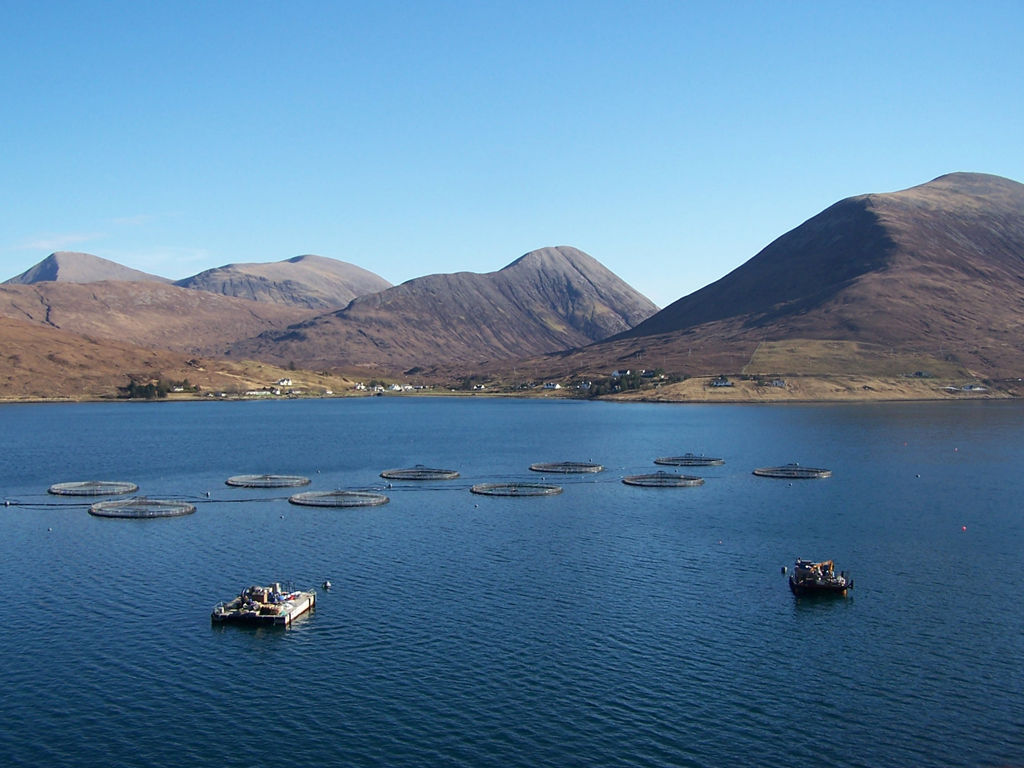Pollution from fish farm pesticides is more widespread than thought and is harming marine wildlife, according to the Scottish Government’s green watchdog.
Monitoring by the Scottish Environment Protection Agency (Sepa) has detected a toxic chemical used to kill the sea lice that plague caged salmon in virtually all 302 samples it took from around eight fish farms.
Sepa is now planning a crackdown on the use of the chemical, emamectin, at new fish farms. In wide-ranging proposals for a long-awaited new regulatory regime for fish farming being unveiled today, the agency also promises to “strengthen” its oversight of the industry.
Critics, however, warned that Sepa is not going far enough, and urged an immediate ban on emamectin. The fish farming industry said Sepa’s new regime would allow “gradual and careful expansion” and insisted it had kept to Sepa guidelines on pesticides in the last five years.
The Ferret reported in 2017 that 45 lochs were polluted by fish farm pesticides. In a series of investigations, we revealed that both Sepa and the Scottish Government had secretly bowed to industry pressure not to ban emamectin, marketed as Slice.
How the Scottish Government ‘nuanced’ away fish farm pesticide ban
Now Sepa is releasing the findings of a new survey in which it analysed 302 samples from 93 sites around eight fish farms in Shetland. It found emamectin in 98 per cent of the samples.
Another lethal sea lice pesticide, teflubenzuron, was detected in 46 per cent of the samples, despite the fact that it hasn’t been used since 2013. Residues of the chemicals were “more widely spread in the environment around fish farms than had previously been found,” Sepa said.
“Moreover, the research concluded that the impacts of individual farms may not be contained to the vicinity of individual farms.”
Sepa’s chief executive, Terry A’Hearn, said: “We’ve concluded that Scottish salmon farm medicine is significantly impacting local marine environments which increases the now substantial weight of scientific evidence that the existing approaches do not adequately protect marine life.”
Sepa agreed with a recent Scottish parliamentary inquiry into fish farming that “the status quo is not an option”, he added. “Which is why we’re announcing firm, evidence based proposals for a revised regime that will strengthen the regulation of the sector.”
Sepa is going to adopt a “precautionary principle position” and impose “much tighter “ limits on the use of emamectin – though only on new fish farms. “This interim standard will set a limit so low that it will, effectively, mean emamectin can only be discharged in very limited quantities at any new site,” it said.
Sepa has asked a UK scientific advisory group to make recommendations on new environmental standards for emamectin. The Scottish Government will then consult on changing the legal limits for all fish farms.
In its “sector plan” for the aquaculture industry, Sepa is also tightening controls on the amount of faeces and uneaten food that can be dumped on the seabed from salmon cages. It promises “more powerful monitoring using the best available science”.
Sepa will create a new “enforcement unit” to strengthen the the checking of monitoring that fish farms are required to undertake. “Sepa will also increase and strengthen monitoring of the impact of fish farms in surrounding areas,” the agency said.
Scottish salmon farm medicine significantly impacting local marine environments as SEPA unveils firm, evidence-based proposals for a revised regulatory regime. Scotland-wide consultation events announced. Find out more https://t.co/vWgY0I5GHA #aquaculture #fishfarms #salmonfarms pic.twitter.com/17n5W9SXFm
— Scottish Environment Protection Agency (SEPA) (@ScottishEPA) November 7, 2018
Another of Sepa’s proposals, which are going out for consultation, could allow bigger fish farms in “sustainable” locations. “Overall, the proposals will combine to encourage operators to site and operate their fish farms in environmentally less sensitive waters and use improved practices and technologies to reduce environmental impact,” Sepa said.
“In practice, we anticipate this will lead to fewer fish farms in shallower, slow-flowing waters and more fish farms in deeper and faster-flowing waters. We also anticipate it will encourage the adoption of new technologies such as partial and full containment to capture organic waste and any remaining medical residues.”
In 2017 nearly one in five salmon farms failed Sepa’s pollution assessments, with 56 of Scotland’s 297 farms rated as “poor”, “very poor” or “at risk”. Overall compliance for the industry dropped from 86 per cent in 2016 to 81 per cent in 2017.
Initial reactions to Sepa’s reforms were sceptical. “This is welcome research that further demonstrates the profound impact industrial fish farming is having on Scotland’s marine environment,” said the Scottish Greens environment spokesperson, Mark Ruskell MSP.
“However, the proposals to tighten regulations for fish farms simply don’t go far enough, and may result in even larger farms. Further expansion of this industry whilst such serious concerns remain is unjustified, and a moratorium on new farms is urgently needed.”
He added: “Any future expansion of this industry should be dependent on firms proving they can solve welfare and environmental problems through technical innovation. As the price of salmon continues to go through the roof, this is an industry that makes a lot of profit and can easily afford the cost of meeting the demands of far more stringent regulation.”
The National Trust for Scotland backed the call to halt the growth of the salmon farming industry. “We welcome the attempts to curb the huge quantities of toxic chemicals discharged by fish farms that have been blanketing the seabed,” said the trust’s senior nature conservation adviser, Dr Richard Luxmoore.
“But we are concerned that proposals to increase the maximum size of individual farms will exacerbate the release of infective parasite larvae into our coastal waters where they pose a severe threat to wild fish populations. Until this and other environmental threats posed by salmon farms are effectively controlled we would like to see a moratorium on the further expansion of the industry or establishment of new farms.”
Don Staniford, of Scottish Salmon Watch, said: “Given the recent damning scientific evidence, Sepa should immediately ban the use of toxic chemicals. Salmon farming cannot be allowed to continue to kill lobsters and other shellfish.”
He described the tightening regulatory regime as “a shot across the bows” of both the Scottish Parliament and the Scottish Government. “Sepa is finally showing some bark if not bite,” he argued.
“The Scottish Government’s plans to double or even treble salmon farming production to 400,000 tonnes by 2030 are surely now blown out of the water.”
The Scottish Salmon Producers’ Organisation (SSPO) stressed that it shared Sepa’s vision of an “innovative, sustainable salmon industry” underpinned by clear and accurate regulation.
“This report will remove many of the barriers preventing the development of more modern facilities further from the shore and we look forward to Sepa’s support as the industry makes this change,” said SSPO chief executive, Julie Hesketh-Laird.
“This is a rigorous report setting out the modern regulation the industry needs to enable it to grow sustainably over the long term. It is the culmination of years of collaborative work between the Scottish salmon farmers and Sepa to develop a new framework for the gradual and careful expansion of the Scottish salmon sector.”
She added: “The discovery of (pesticide) residues is important information but it should be remembered that salmon farmers were operating to Sepa guidelines throughout the past five years. We look forward to contributing to the consultation.”
SSPO accepted that the industry’s environmental performance had faltered in 2017. “The salmon farming industry has good levels of compliance but there has been a small dip in performance and we are keen to see that improve,” the organisation said.
In June 2018 The Ferret published hundreds of official photos showing damaged and diseased salmon from fish farms. In September we revealed underwater video footage of lice-infested salmon in a cage off the island of Lewis, prompting government investigations.
This story was updated at 09.50 on 7 November 2018 to include comments from the National Trust for Scotland.
Photo thanks to Richard Dorrell, CC BY-SA 2.0, via Wikimedia Commons.















The un-answered question in all of the pesticide issue is whether these noxious substances can be driven ashore in aerosol form. Any entomologists out there willing to do a study on the dearth of insect life in west coast Scotland, despite land based agriculture being almost non existent ? Possible effects on humans ?